February 5, 2014
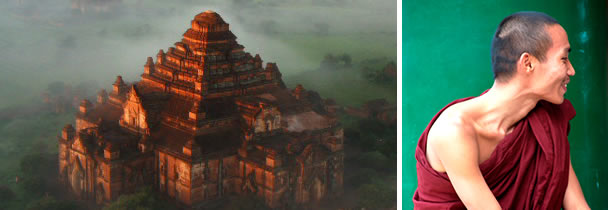
“Mingalaba!” was the first word I heard each morning as I strolled onto the powdery sand of the Bay of Bengal for my swim in the turquoise-blue and dead-calm waters.

This “auspicious greeting” from the security guard is something you will never forget after spending a couple of weeks with the remarkably welcoming Burmese people. I was often reminded here that a smile costs nothing but gives much.
Climbing up my first temple in Bagan was a defining moment on my journey: the vibrant green landscape is dotted on all sides with more than three thousand temples, the survivors of an estimated eleven thousand which in the 11-13th centuries adorned a thriving city of a million people.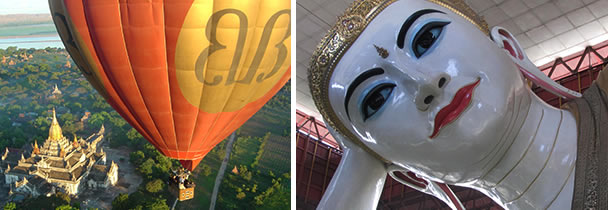
The sheer scale of it all is even more evident from a hot air balloon. The sense of calm as you drift over all these small and large monuments to Buddha is breath taking and leaves you in no doubt that Buddhism is at the heart of Burmese life. The pilot’s skill, as we skimmed the tops of trees and tips of pagodas, was impressive; he even managed to land at a designated spot where the crew awaited with refreshments. But for the fact that a general built a road through the temple area to his riverside residence, this could well have been a Unesco designated site by now.
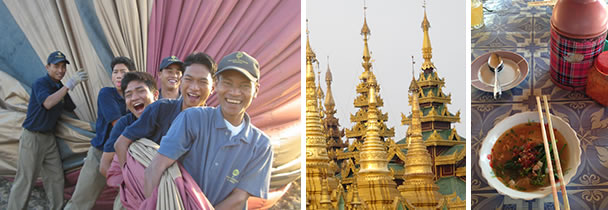 There is no doubt that better governance is coming to Myanmar, and tourism of course brings huge benefits to local people. But it is likely that the main sites are going to become more mass-market destinations before long. The beautiful Inle Lake, which is populated by villagers who live in houses on stilts and sustained by floating gardens, has recently had some six hundred acres of its shores designated for new hotels despite its being a sensitive environmental area, and even more areas will soon be opened up for tourism.
There is no doubt that better governance is coming to Myanmar, and tourism of course brings huge benefits to local people. But it is likely that the main sites are going to become more mass-market destinations before long. The beautiful Inle Lake, which is populated by villagers who live in houses on stilts and sustained by floating gardens, has recently had some six hundred acres of its shores designated for new hotels despite its being a sensitive environmental area, and even more areas will soon be opened up for tourism.
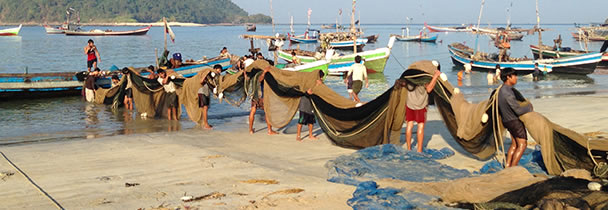 After we had cruised on a very comfortable boat up the legendary Irrawaddy River to Mandalay we moved much further east to Pyin Oo Lwin which is situated in Shan state. Under British rule this was the summer capital, and its expansive botanical gardens were designed by Lady Cuffe.
After we had cruised on a very comfortable boat up the legendary Irrawaddy River to Mandalay we moved much further east to Pyin Oo Lwin which is situated in Shan state. Under British rule this was the summer capital, and its expansive botanical gardens were designed by Lady Cuffe.
Of much more interest is Hsipaw which can be found a few hours farther into the hills at the end of a sometimes hair-raising road where there were only two smallish hotels suitable for tourists. It was very cold here in the mornings, and we wore our warmest clothing as our narrow boat headed up the Dokhtawady River. We disembarked to go walking in some totally unspoilt countryside where we came across a very old lady who had been given a small house as she had no relations. In return she looked after the local farmer’s fields. I sat briefly in the $3 bamboo chair she had recently been given.
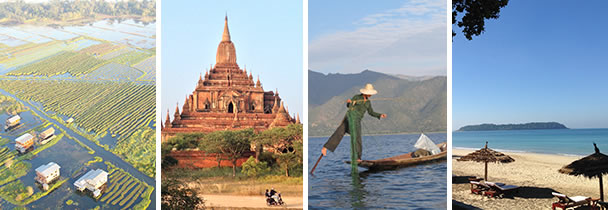 Farther on we came to Son Lon -‘big garden’ – village, and the railway-station mistress offered us tea. She proudly showed us a picture of her son at his initiation as a novice in the nearby monastery. There are no roads here and just two trains a day. Wooden houses perched on stilts are decorated with attractive bamboo latticework and each overlooks an ordered, productive garden. Everything has its place, and the neat rows of vegetables with crotons, aucuba, lantana and mimosa serving as ornamental delineating borders, give one a sense of contained order.
Farther on we came to Son Lon -‘big garden’ – village, and the railway-station mistress offered us tea. She proudly showed us a picture of her son at his initiation as a novice in the nearby monastery. There are no roads here and just two trains a day. Wooden houses perched on stilts are decorated with attractive bamboo latticework and each overlooks an ordered, productive garden. Everything has its place, and the neat rows of vegetables with crotons, aucuba, lantana and mimosa serving as ornamental delineating borders, give one a sense of contained order.
There are mangoes, jack fruit, wood apples, oranges and damsons. Underneath a large lychee tree our guide, known as Mr Bike, told us that ants like making nests in these trees and that their eggs are used to flavour rice. Fish caught from the river are also put in the trees, and ants crawling over the fish urinate on them, giving a pungent, vinegary flavour to the fish once cooked. The planting had both the precision of an English market garden and the yester-year romance of the sub-tropical setting.
Later we stopped at what I suppose could be called a little restaurant which is used by the locals. I showed some interest in what looked like broccoli sprouting in the proprietor’s garden. Some of the plant’s leaves were immediately plucked and put into our Shan noodle dish. Lunch cost about £1 per head. There is a tangible sense of contentment in this rural way of life which seems to be untouched by aspirational striving. This was not, unlike some of the main sites such as Yangon, Bagan, Inle and Mandalay, a wow destination, but a deviation off the well-trodden path is nearly always worthwhile.
The seventy-odd seater ATR planes that connect the main destinations worked well in a slightly chaotic way and check-in seems a lot faster without a computer. You are even given a coloured sticker so the airline staff knows which plane to shepherd you onto. There is a very strong demand for the better hotels, so early booking is needed at peak times.
The main season is from October to March, and I should be delighted to arrange a holiday in Burma for you should you be interested.
Please call for further details. 020 7723 5858.
NB prices shown were current at the time of writing the newsletter and are not necessarily current now.
Please ask for an updated quote.
- The Khajuraho temple complex, a Unesco World Heritage Site
- A Sense of Place: Poignancy in KwaZulu Natal
- A Sense of Place: Northern Botswana
- A Trio of Treats in India
- And now for something completely off grid and different: AFRICA’S ULTIMATE RAINFOREST SAFARI
- A Trio of Treats off the beaten track – We get you to places that others don’t!
- A Trio of Treats On The Rift Valley
- A Sense of Place – Can the muppets save a species?
- Trio of treats (Rajasthan, Maldives and Garden Route)
- A Sense of Place – A favourite place: Tanzania and Ruaha
- A Sense of Place – A favourite place in Botswana: the Okavango with elephants galore
- A Sense of Place – Here be dragons and a dark past
- A Sense of Place – Justice Regained
- A Sense of Place – Summer rains make the roads impassable
- A Sense of Place – ‘Those two ladies put light in my future.’
- A Sense of Place – The bird who lost its nest
- A Sense of Place – Talking with the Maasai
- Newsflash: first American guests to Tanzania since March 2020
- A Sense of Place – AFRICA NEEDS YOU
- Escape to Italy?
- Covid: the road still to be travelled.
- A trio of treats. Series of 3 (Part 3): Tiger reserves.
- A trio of treats. Series of 3 (Part 2): Khajuraho.
- A trio of treats. Series of 3 (Part 1): Lucknow.
- A Sense of Place – Engaged people may save the planet
- A word on lions and a trio of treats
- A Sense of Place – India’s most holy city
- A wealth of wilderness walks in Namibia
- Travel snippets from Miles
- A trio of treats on the green island of Pemba in the Zanzibar archipelago
- A Sense of Place – THE INSIDE TRACK on Cape Town guiding
- A Sense of Place – Migrations of people and beasts: East Africa
- A Sense of Place – An era of revolution and global alliances
- A Sense of Place – A walk on the wild side
- A Sense of Place – The ghost ingredient is back
- A Sense of Place – Liuwa Plains and Kafue National Parks – Zambia
- A Sense of Place – Literati in the Pink City, the Capital of Rajasthan
- A Sense of Place – A Tamil town still connected to Europe, Art Deco architecture, and temple antiquity in Southern India.
- A Sense of Place – Dreamy aquamarine sea and stunning safari with the Makuleke people
- A Sense of Place – A trio of lovely ladies in Hyderabad
- A Sense of Place – Entamanu, the wishing tree and walking with the Hadza tribe.
- We get you to places that others don’t… St Helena, Gt Zimbabwe ruins and Papua new Guinea
- A Sense of Place – Walking in the hippie hills of the Himalayas
- A Sense of Place – The Okavango: the river that never finds the sea
- A Sense of Place – The Great Rift Valley, Laikipia, Samburu warriors and Maasai Olympics.
- A Sense of Place – Escape the world in the Namib Desert
- Africa is a massive continent: a collection of 55 countries
- A Sense of Place – Zambezi Watery Wilderness
- A Sense of Place – Burma: the road beyond Mandalay
- Lake Malawi – Would you rather pay for the advertising or the experience?
- From shoe-shine boy to tourist guide in Ethiopia
- A Sense of Place – Ladakh, the Himalayas
- Dhow sailing, Lions are back in Malawi, Self-drive in Namibia
- Sacred rivers and forts, India
- Piranhas, sting rays, caimans – and still people go into the River Negro!
- Kerala, Southern India – God’s own country
- South Africa: Crucible of the rainbow nation
- Madagascar: croissants and lemurs
- Argentina vs Africa on wildlife drama
- Uganda – Gorillas and Gardens
- Mozambique & Kenya: immigration official on holiday
- Mozambique: Gorongosa and reconciliation in the bush
- Zimbabwe is ready for Tourists again
- Serengeti ecosystem and unbeatable savannah
- Lamu: crab complaining
- Kenya: circumcision
- Zambia: Ellie rescue
- Africans: always smiling
- Tswalu
- French sketch
- Kenya: the best hosts
- First visit to Africa 1986
- Namibia, Namib Rand, Skeleton Coast and the ultimate flying safari
- A few gems off the beaten track: Fanjove Island, Tanzania; The Singular Hotel, Patagonia and Isla Palenque, Panama.
- Elephant relocation, quad bike expedition and new Sossusvlei reserve
- Templed out in Tamil Nadu and elephant refuge in Jaipur
- Kenyan sanctuary and family run camp in Zambia
- Australia: Arkaba, Tasmania and Lord Howe Island
- Australia: in the outback and off the beaten track
- India: heavenly Himalayan hideaways, Botswana: fun safari for children and Argentina: hidden homestay in a mountain desert
- Limpopo retreat, Serengeti spectacle and adventure on the Zambezi
- Value for money in Kenya and the trail less travelled in Peru
- Lions in danger, free nights and a new coastal gem
- G and T on demand, hidden beach, micro-light and sleeping on a dam
- Off the beaten track